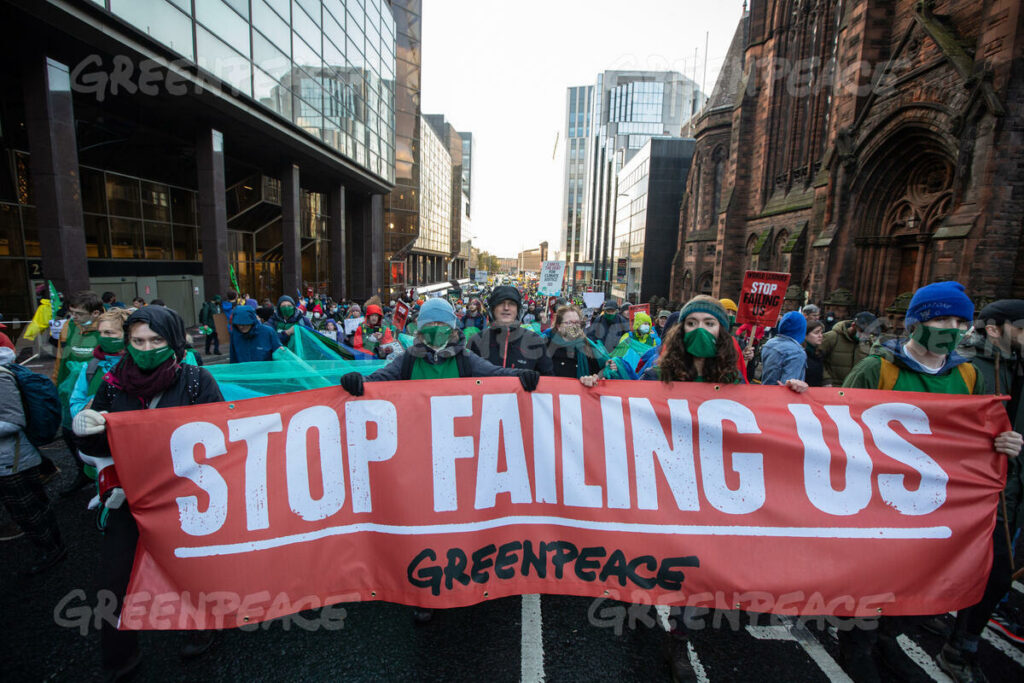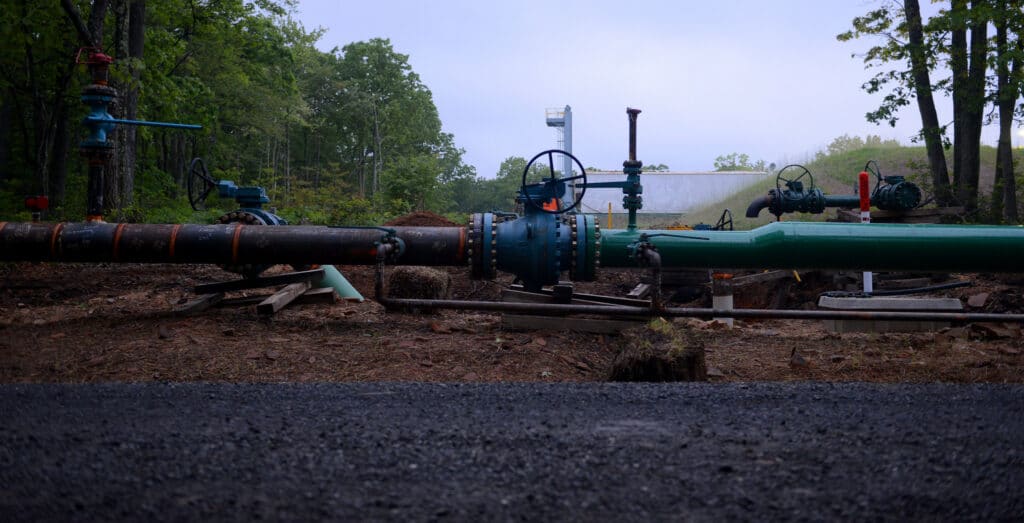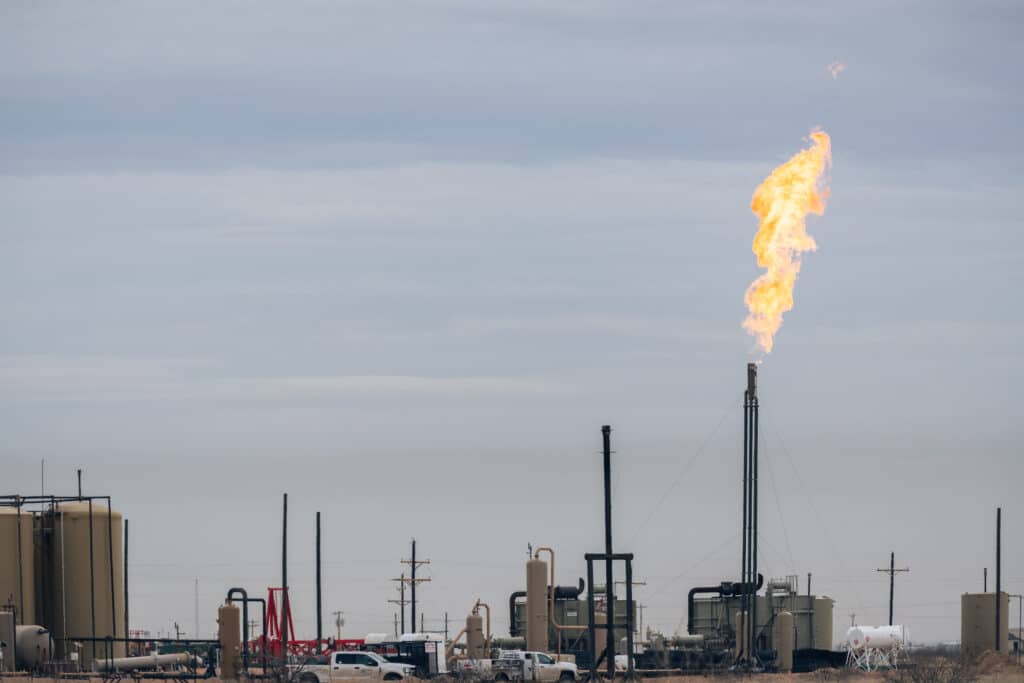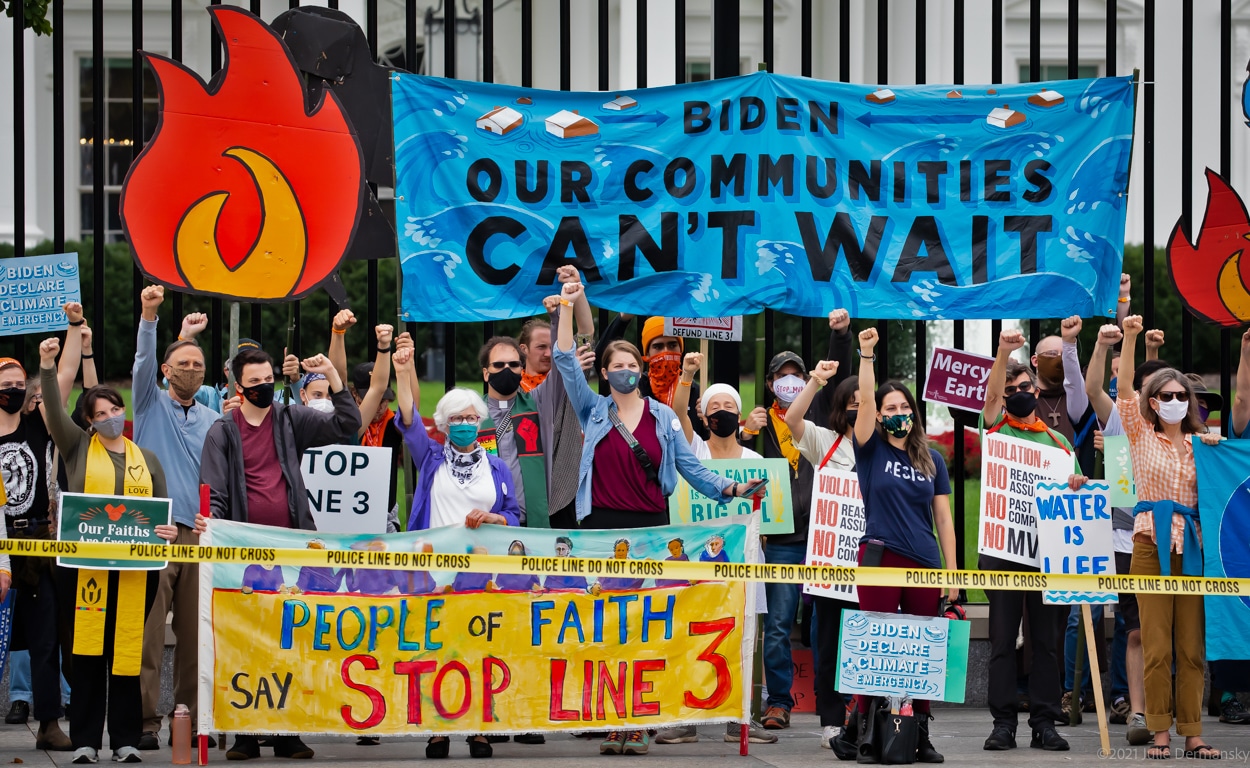As 2021 comes to a close, we look back on a year that was full of climate chaos, relentless oil industry propaganda, and frustrating progress on reducing greenhouse gas emissions. But 2021 also saw a significant number of victories against the expansion of the fossil fuel industry in the U.S. and around the world, and some glimmers of hope for climate action.
The year started with a conspiracy-fueled coup plot on the U.S. government by President Trump and his supporters in what was ultimately a failed attempt to stay in power. Two weeks later, President Biden was sworn into office, and he quickly signed a flurry of executive orders that included the cancelation of the Keystone XL pipeline and a pause on new oil and gas leases on federal lands. Those moves signaled an intention to prioritize climate change during the Biden era after years of giveaways to the fossil fuel industry.
But the oil industry and its allies fought hard this year to delay meaningful climate policy, part of a decades-long campaign to protect corporate profits at the expense of people and the planet. Campaigns of misinformation and misleading PR continue to characterize public discourse around energy and climate change, even as those corporate strategies and tactics evolve.
On a hopeful note, renewable energy and electric vehicles made substantial strides, putting the entrenched fossil fuel industry on the defensive. Looking forward, the clean energy transition will continue to progress even absent big federal policy. And strong grassroots movements once again demonstrated their ability to stop major oil and gas pipeline projects around the country, even against steep odds.
Biden Administration Actions
President Biden held an international climate summit in April, where he unveiled a 50-52 percent emissions reduction target by 2030, and over the course of his first year in office he announced a slew of executive actions: new U.S. Environmental Protection Agency (EPA) regulations on methane emissions from oil and gas wells, a cutoff of financing for overseas fossil fuel projects, and ordering the federal government to achieve “net zero” emissions from its buildings and operations by mid-century, for example.
But his administration has not implemented the policies needed to get to the 2030 target, and in many cases, Biden has backed down from taking on the fossil fuel industry. The Biden administration, for example, has given up on its plan to freeze new drilling leases on federal lands, and auctioned new acreage to the oil industry in the Gulf of Mexico in November, with more auctions slated for 2022.
The Department of Interior also published its review of the federal oil and gas leasing program in November, and stopped far short of putting limits on new drilling on public lands, as President Biden had promised during the 2020 presidential campaign.
And while President Biden scrapped Keystone XL, his administration has declined to intervene when it comes to other pipelines, including not shutting down the Dakota Access pipeline, despite the project continuing to operate without a valid easement. Meanwhile, even as the state of Michigan is seeking the closure of the 68-year-old Line 5 pipeline, which poses water quality and safety risks to the Straits of Mackinac, the Biden administration has not taken a position.
Biden looked the other way on the Line 3 pipeline, while water protectors were arrested in droves in northern Minnesota as they attempted to interrupt construction. Enbridge, the pipeline’s owner, completed construction of the oil sands pipeline in early October over vigorous opposition led by Indigenous activists.

Any hope of large-scale emissions reductions during the Biden era will come from the Build Back Better Act, the climate and social policy bill which has $550 billion in renewable energy and electrification programs. At the time of this writing, after a half-year of negotiating, the bill is in limbo at the behest of Senator Joe Manchin (D-WV), who profits from coal industry interests.
Meanwhile, in a sign of how thoroughly the administration is playing on the oil industry’s turf, it has accepted the misleading assertion put forward by the oil industry that only more drilling will resolve current high energy costs.
Not only did the Biden administration call on Middle East oil producers in OPEC to produce more oil, but it has repeatedly called on the fracking industry to drill more. Secretary of Energy Jennifer Granholm said in mid-December that a ban on crude oil exports was not on the table, and she urged frackers to increase their drilling activity.
“I do not want to fight with any of you,” Granholm told the National Petroleum Council, whose members include the executives of ExxonMobil, Chevron, BP, and other oil companies. She urged drillers to “please, take advantage of the leases that you have,” and, she also urged them to “hire workers. Get your rig count up.”
Pleas for more drilling came only a few weeks after the COP26 international climate talks in Glasgow, the closely-watched follow-up to the 2015 Paris Agreement. President Biden appeared in Scotland to trumpet U.S. climate action, where his soaring rhetoric was conspicuously not reflected in climate policy back home.
His appearance was illustrative of the summit on the whole. COP26 had some notable successes, including calls to “phase down” coal around the world (but not a “phase out”), and incremental ratcheting up of emissions targets and renewed commitments for financial aid to developing countries, but the international meeting was widely seen as another failure of global leaders who talk a lot about climate change but refuse to do what is necessary to cut emissions.

Fossil Fuel Wins and Losses
Many of the notable developments on climate change and energy came outside of federal government policy.
ExxonMobil and Chevron lost several high-profile battles with their own shareholders. Exxon lost multiple seats on its board to an investor group demanding a more aggressive shakeup of corporate strategy, a particularly striking development given Exxon’s steadfast pursuit of oil and gas production growth, which stands out even among its peers.
Since then, Exxon has kept its spending on new oil and gas projects in check, even if a wholesale corporate transformation is not underway. On the same day that Exxon and Chevron suffered investor blowback, a Dutch court ruled that Royal Dutch Shell must cut its emissions by 45 percent by 2030.
Meanwhile, ExxonMobil’s lobbyists were exposed this year, admitting on tape to “aggressively fight[ing] some of the science” of climate change and supporting “shadow groups” that oppose climate action. A few months later, the U.S. House of Representatives brought the executives at Big Oil into a committee hearing on climate disinformation.
Taken together, the events were something of a reckoning for Big Oil, and illustrated the dramatic upheaval in global financial markets, with the transition of financial flows away from fossil fuels and towards clean energy moving into a higher gear in 2021. Aggressive production growth is no longer a tenable position for oil and gas companies.

2021 also saw several major oil and gas pipeline projects reach their denouement – with victories for both industry and pipeline opponents alike.
The PennEast pipeline, a natural gas pipeline that would have carried gas from the Marcellus Shale to eastern Pennsylvania and New Jersey, won a highly anticipated case in the U.S. Supreme Court in June, granting the pipeline company the right to condemn state land for the project’s construction. However, the victory was a pyrrhic one; the pipeline was canceled three months later due to the inability to obtain state-level water quality permits.
The campaign against the Mountain Valley pipeline, a gas pipeline that would carry Marcellus shale gas to the southeast, is ongoing. In early December, the project suffered an enormous blow when its permit for a compressor station that would have allowed for a southern extension into North Carolina was rejected by Virginia regulators.
However, on December 14, a separate regulatory body approved a key permit for the main section of the pipeline through Virginia, despite an extensive track record of water quality violations by the company building the pipeline. The project still needs to obtain multiple permits at the state and federal level, and while it is aiming to reach completion in the summer of 2022, pipeline opponents contend that completion is far from assured.
Another Marcellus gas pipeline, the Mariner East 2, was hit with criminal charges by Pennsylvania’s Attorney General for environmental crimes in October. The 300-mile gas pipeline running the length of southern Pennsylvania, remains under construction even as it struggles with technical problems on terrain prone to sinkholes, erosion, and landslides. Completion of Mariner East 2 is also uncertain.

Other campaigns to block fossil fuel projects were more decisive. In July, activists in Memphis defeated the proposed Byhalia pipeline, an oil pipeline that would have cut through a predominantly Black community in the city.
Meanwhile, activists put two more nails in the coffin of the fossil fuel expansion in the Pacific Northwest. In January, Washington state regulators nixed what would have been one of the largest gas-to-methanol projects in the world, after several years of opposition from community groups.
Then, bookending the year, in early December, the 15-year battle against Jordan Cove, an LNG project proposed in southern Oregon, and its associated Pacific Connector gas pipeline, finally came to an end. Oregon landowners, environmental groups, and Native American tribes celebrated the project’s demise.
Several high-profile defeats of long-distance pipelines now have observers wondering if the era of major pipeline building has come to an end.
Energy Transition Picks Up Speed
Another promising trend that is gaining momentum is the proliferation of bans on natural gas hookups in new homes and businesses, which would eliminate a growth market for gas. Over 50 cities, primarily on the West Coast, have prohibited gas hookups in new construction, but New York City appears to join the group, with the City Council passing legislation on December 15 to become the largest city yet to block new gas connections.
The rapid growth of renewable energy and electric vehicles is also accelerating. While U.S. policy is fickle, the economics of clean energy have only grown clearer. Solar and wind are growing faster than ever, and 2021 saw a seismic shift in the auto industry, with just about all major global automakers committing to shifting towards electric vehicles.
To bolster the trend, over 50 U.S. utilities have joined together to speed up the build out of a nationwide EV recharging network. Based on clean energy’s superior technology and cost profile compared to fossil fuels, the transition is inevitable. The only question is how quickly and how smooth the transformation will be.
Climate Denial and Misinformation
Campaigns of misinformation unsurprisingly remained a prominent feature of climate change discourse in 2021, although efforts to expose industry-backed PR campaigns hit new milestones even as the tactics continue to evolve.
In a shift away from overt climate denial, the fossil fuel industry is now leaning very heavily on proposing false solutions and positioning themselves as leading actors on solving climate change, with misleading campaigns to promote gas-reliant blue hydrogen, “renewable” natural gas, “net zero” commitments, and carbon capture. Delay is the new form of climate denial, and false green solutions and promotional PR are central features of this new corporate strategy.
Right-wing and fossil fuel-backed groups also falsely blamed climate policy for high energy prices and rising inflation in the U.S., and then quickly pivoted to arguing that more fossil fuels are the solution. Those efforts have paid off – fears of high gasoline prices and inflation have put the Biden administration on the back foot and arguably delayed and watered-down the Build Back Better Act.

Worsening Crisis
All the while the climate disasters continue to increase in severity and frequency, and 2021 was a banner year on that front, with a frightening display of climate chaos across the globe. Freezing storms in Texas, a record hurricane on the Gulf Coast, floods in China and Germany, horrific wildfires in California and Siberia, record temperatures from the “heat dome” in the Pacific Northwest, the “atmospheric river” that inundated British Columbia, and the December tornadoes in Kentucky and dust storms across the Great Plains.
We head into 2022 with a mix of dismay, fear, anger, and a bit of hope. The climate crisis is becoming more severe and more daunting. Progress is dismally slow and governments of all stripes have been unwilling to take decisive action. Industry propaganda continues to muddy the public sphere. The Biden administration’s signature climate policy is hanging on by a thread.
At the same time, the oil industry is on the defensive, with growth prospects nearly closed off. It is losing both its social license from the public and the battle of economics. And environmental and social movements have repeatedly demonstrated that they can block, delay, or halt what may seem like an inevitable industry expansion.
As climate disasters continue to mount, these dynamics – both positive and negative for the climate movement – are likely to intensify.
We’ll continue to report on these events in 2022 and beyond.
Subscribe to our newsletter
Stay up to date with DeSmog news and alerts






